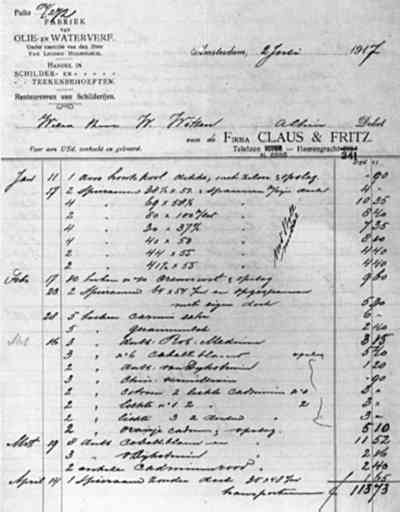WITH PAINT FROM CLAUS & FRITZ: A STUDY OF AN AMSTERDAM PAINTING MATERIALS FIRM (1841–1931)
MICHEL LAAR, & AVIVA BURNSTOCK
2 THE FIRM OF CLAUS & FRITZ
The founder of the firm in 1841 was Pieter Claus Jr. (1778–1864), a painter of landscapes and townscapes. That same year it moved into the premises at 295 Herengracht, where it remained for more than 50 years (fig. 5). In 1853 Harmina Christina Louisa Claus (1834–99), (fig. 6), Pieter's daughter by his second wife, married the painter Johannes Fritz (1823–91) and from that year on the firm appeared as Claus & Fritz in the directory of the leading inhabitants of Amsterdam, although Claus also kept his own entry in the directory until his death. From 1856 on the entry read “Claus (P.) Art Dealers in Painting and Drawing Materials, Claus & Fritz, at the address given above.” The letter of recommendation indicates that the firm manufactured paints from 1841, but whether they and other artists' requisites were made at the same address as the shops unclear. The premises there were certainly none too large. That the firm also dealt in paintings is clear from these entries as well as from the account books of Cornelis Springer (1817–91), from whom it bought six pictures between 1842 and 1862 (Laanstra et al. 1984, cat. nos. 42–3, 52–2, 52–5, 54–4, 54–16, and 62–5).
Fig. 5.
295 Herengracht, Amsterdam, shown in 1915, just before the house was torn down. The second house from the left has the name Claus & Fritz painted on the facade. Photograph courtesy of the Gemeente Archief, Amsterdam
 |
Fig. 6.
Harmina Christina Louisa Fritz-Claus (1834–99). Photograph by F. W. Deutman, Amsterdam, now in the possession of J. C. van Cleef, Hoogezand, Netherlands
 |
After Claus's death the firm retained the name Claus & Fritz, as it did again after Fritz's death in 1891, when it was continued by the art dealer and painter from Gouda, Bartholmeus Johannes van Maare (1837–1913), who bought the Herengracht premises on Fritz's widow's death in 1899. In 1909 the descriptive “Art Dealers” was dropped from the firm's title, which now read “Makers of Oil and Water Colors in Tubes, Canvas, etc. Dealers in Painting and Drawing Materials” (fig. 7).
Fig. 7.
Advertisement by Claus & Fritz from the Adresboek van Amsterdam, 1909. Photograph courtesy of the Historisch-topografische Atlas van het Gemeente Archief, Amsterdam
 |
After Van Maare's death the firm was taken over by his sons Jacobus (b. 1866) and Dirk (b. 1868), who sold 295 Herengracht in 1913 and on January 1, 1914, turned the business into a limited company under the same name, although “Van Maare Brothers” was now added in brackets after the name Claus & Fritz in advertisements. The new premises were at 341 Herengracht (fig. 8). The Van Maare brothers made not only “Fine Oil and Water Colors in Tubes” but also paper, canvas, and panels for painters. An advertisement in the 1915 catalog of the Moderne Kunstkring in Amsterdam reveals that they also sold “study paint,” presumably a student grade paint of lower price. The firm finally went into liquidation in 1931, probably driven out of business by the competition not only from imported paints in the early 20th century but also from the firm of Talens, founded in 1899, which rapidly captured the lion's share of the Dutch market in the 1920s.
Fig. 8.
Invoice from Claus & Fritz to the artist Willem Witsen, 1917. Photograph courtesy of the Rijksmuseum, Amsterdam
 |
|



